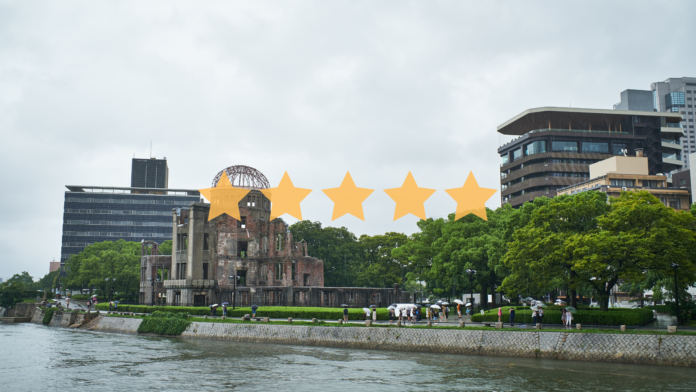79 years on, this raw and powerful documentary brings viewers face-to-face with the last of the so-called ‘Hibakusha’, the survivors of the atomic bombings that ended WW2 for Japan.
★★★★★
Content warning: this review contains reference to atomic warfare and violence against civilians.
Last month marked a year since Christopher Nolan’s Oppenheimer released to near-universal acclaim, becoming one of 2023’s biggest blockbusters in the wake of the ‘Barbenheimer’ phenomenon and director Christopher Nolan’s own star power. The film generated an enormous amount of debate, with particular controversy around how the film avoided actually depicting the atomic bombings of Hiroshima and Nagasaki. Many have argued that this was not in fact necessary for the story this film was trying to tell, which focused on J. Robert Oppenheimer himself, as well as the wider implications of his work for the future. Hiroshima and Nagasaki are, in many ways, not the focus of that film, and arguably, the full horrors of these bombings was not something that any standard theatrical release could truly capture. Ultimately, the best way to convey the reality of what happened is simply to sit down with the people who were actually there, and let them tell their stories.
This is precisely what viewers get with Atomic People, the recent documentary from the BBC which tells the story of the ‘Hibakusha’ – a Japanese name for the survivors of the bombings. With this month marking 79 years since the bombings of Hiroshima and Nagasaki, these few remaining Hibakusha are the very last of a dwindling number of people for whom this event was part of living memory. Over the course of an hour and a half, these few remaining individuals are given the chance to retell their stories in what makes for a horrifying, unforgettable watch.
The film is one that focuses entirely on these survivors’ testimonies. Throughout, there is a sense of immediacy often lacking in other documentaries, there being no voiceover narration for instance. Instead, the key facts of what took place are conveyed simply through brief snippets of text, interspersed with the survivors’ own statements, as well as some truly harrowing, uncensored photos and footage of the devastation that was caused.
Even for history enthusiasts, those who may think they are well read on the topic at hand, and who understand the level of destruction involved, much of the content included here will shock. Atomic People does not flinch from depicting graphic, rarely publicised images taken in the aftermath of the attacks. It shows not just the most famous pictures of devastation, but also those of burnt bodies, horrific deformities, and bones littering the ground.
Meanwhile, we hear from the Hibakusha themselves speaking on the things they saw and experienced, telling stories of people walking along with their skin peeling off, their organs in their hands, of children digging mass graves for their classmates, or of the day turning to night. These interviews are filmed in a manner that is shocking for its simplicity. We see into the homes of these survivors, watching them greet the interviewers, discussing their own hobbies or interests. One scene, in which one elderly woman from Nagasaki recounts seeing hundreds of the wounded littering a beach, crying out for water, before cutting to her own prayers and offerings of water to the Buddha, is utterly heart wrenching.
The film covers not only the experience of the bombings themselves, but also focuses on the experience of the Hibakusha in the years afterwards, and the toll that it took on those who walked away. It is perhaps this section of the film, which goes beyond simply the immediate effects of the bombs, which in many respects is the most shocking.
Tales from several of the Hibakusha on how the US worked for years to suppress information on the bomb even as survivors of the initial blasts fell victim to radiation, or of how they deliberately used cancer victims as test subjects, are as blood curdling as anything else the film touches on. Meanwhile, the scene in which an otherwise healthy and happy couple reflect on their decision not to have children for fear of the consequences, is utterly heart-wrenching, and effectively gets across the long shadow that was cast by these events.
The closing scenes, in which several of those survivors who are still living describe their efforts to raise awareness, makes for a truly powerful ending that speaks to the experience of this scarred generation. The footage of the elderly Mr Kido, as he journeys to New York to speak before the UN, to warn of the dangers of nuclear warfare in the future, and of the devastation seen in Gaza and Ukraine, is a moment that will sit with many viewers for a long time, for how it speaks to the strength of those who survived, and to the dangers that still exist.
The Verdict
An unflinching, visceral documentary that retells the horrors of the atomic bombings of Japan through the testimonies of the survivors themselves, this is a painful but important film to see as the last survivors of the bombs reach old age.
Atomic People is available now on BBC iPlayer.
Words by Daniel Goldstraw
Support The Indiependent
We’re trying to raise £200 a month to help cover our operational costs. This includes our ‘Writer of the Month’ awards, where we recognise the amazing work produced by our contributor team. If you’ve enjoyed reading our site, we’d appreciate it if you could donate to The Indiependent. Whether you can give £1 or £10, you’d be making a huge difference to our small team.
